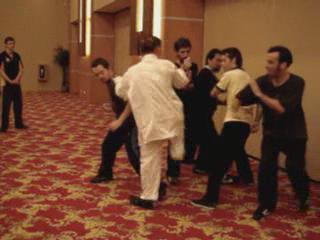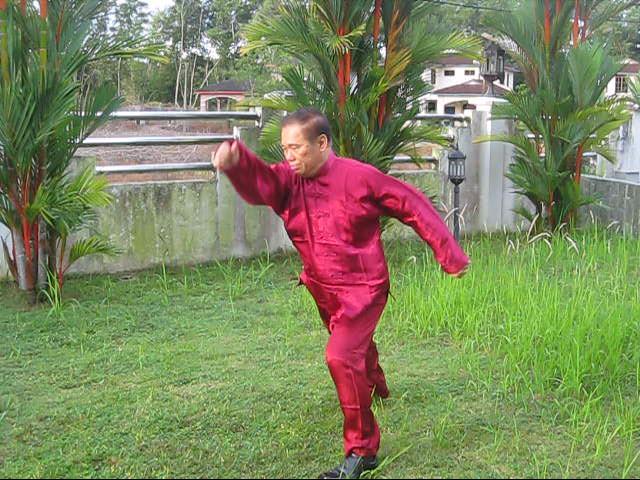SHAOLIN CHIN-NA AND MULTIPLE FIGHTING

A high-level master can use chin-na for multiple fighting
Question
Would Shaolin Chin-na be suitable for handling multiple opponents?
If so, which sequences would be most suitable? And how would the tactics and strategies be different from Choy Lee Fut, an art known for fighting multiple opponents?
FJ
Answer
Would Shaolin chin-na be suitable for handling multiple opponents? The answer is yes and no, depending on various factors.
If the exponent is highly skillful, chin-na is effective for handling multiple opponents. If he is not skillful, chin-na techniques are not suitable in multiple-opponent fighting.
Chin-na requires high-level skills. A chin-na master has to make four moves before his opponents can make one. However, a skillful master can do so readily, and the required factor is not just speed.
If a chin-na master wishes to show compassion in his fighting against multiple opponents, he can apply a suitable chin-na technique on an opponent and use him as a shield against other opponents so that they cannot attack him. If he wants to escape from multiple opponents, or hurt them seriously, without worrying about being compassionate, using strikes instead of chin-na is more effective. A less skillful exponent would not have such choices, and using chin-na would not be suitable for handling multiple opponents.
Any one of the 72 chin-na sequences is suitable, though some sequences may be more appropriate for certain situations. For example., if a nearly opponent kicks at a chin-ma master, the master can exploit his kick and apply the sequence “White Ape Ascends Tree”. However, if the master does not know this sequence, or does not want to use this sequence, he can use any other sequence he likes.
The tactics and strategies of chin-na are different from those of Choy-Li-Fatt, which is well known for fighting multiple opponents. A chin-na master is highly skillful, and he usually fights against opponents who are less skillful. He has control over his opponents and therefore he can afford to fight compassionately. If an opponent is more skillful than him, he strategy would be different, and his strategy is to escape without being injured.
The strategy is the same whether he fights against one opponent or many opponents. This strategy is not suitable for a practitioner who is not skillful.
The strategy of a Choy-Li-Fatt master is different. The strategy is to injure his opponents seriously or to escape unhurt if he is able to defeat them. The nature of Choy-Li-Fatt techniques is such that a Choy-Li-Fatt practitioner has to be destructive. There are not many techniques in Choy-Li-Fatt to enable a practitioner to be compassionate, unlike in chin-na.
This does not mean that a Choy-Li-Fatt master cannot be compassionate in his fighting. If he wants to be compassionate, he avoids hitting his opponents, i.e. he stops short of target when applying his Choy-Li-Fatt techniques. If he does not control his strikes and allows the strikes to hit his opponents, they can be seriously injured. It defeats the purpose of Choy-Li-Fatt if its techniques do not injure opponents seriously.
The tactics of chin-na are to tempt opponents move in certain ways that it is easy for the chin-na master to apply chin-na techniques on them. For example, the master may purposely leaves an opening for his opponents to strike or kick, so that he can apply chin-na techniques on the striking arms or kicking legs.
The tactics of Choy-Li-Fatt are different. A Choy-Li-Fatt exponent has no time to “play” with his opponents. When opponents strike and kick, he hits their arms and legs. If they are hesitant or retreat, he hits their body. His arms are like two pieces of iron rods.
If the Choy-Li-Fatt exponent is confident of defeating his opponents, he strikes them down decisively, like breaking their arms and legs or causing them serious internal injury. If he finds his opponents overwhelming, he opens a way with his arms like iron rods, and escapes.

Choy-Li-Fatt Kungfu is well known for fighting multiple opponents
The questions and answers are reproduced from the thread 10 Questions on Shaolin Chin-Na in the Shaolin Wahnam Discussion Forum.
LINKS
